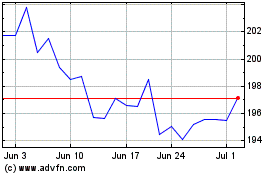Live Cattle Auctions Make a Comeback Online
December 17 2016 - 7:29AM
Dow Jones News
By Kelsey Gee
Unruly trading of cattle futures is leading to a revival of live
auctions, as ranchers look to bring robust pricing data to the
market and guide understanding of supply and demand in their
industry.
Cattlemen trade futures, or contracts to buy or sell cattle at a
given price on a future date, as a form of insurance on their
borrowings to feed hundreds or thousands of animals at a time. In
the past year, values of cattle futures contracts have swung
wildly, from near-record highs to six-year lows.
A nearly one-third drop in the price of cattle futures through
the fall of 2016 has slashed ranch incomes and prompted
investigations into the source of the volatility.
The Chicago Mercantile Exchange is considering drastic changes
to how those contracts are settled. The world's largest futures
exchange has been working with cattlemen to address the apparent
breakdown in the $13 billion market, proposing among other measures
a new index to guide pricing of futures contracts.
CME Group Inc. says an index could help align futures contracts
with real trade data. The index could be built on cattle purchase
prices that meatpackers are required by law to disclose to the U.S.
Department of Agriculture.
Some ranchers say such a price index would make volatility in
the futures market worse. USDA price reports can lag behind actual
deals by hours or even days, meaning the index might not represent
current sales.
Nonetheless, the reports "do provide transparency to the
market," says Dave Lehman, CME's managing director of commodity
research.
The lack of public bartering and price transparency in the
cattle industry is one major source of the market's problems, CME
says. At present, the predominant way of selling cattle is via
private production contracts between feedyards and the four big
U.S. meatpackers. So-called formula contracts price cattle ahead of
sale based on the benchmark price independent cattlemen will get in
the cash market, plus or minus premiums and discounts.
Some feedyard operators now are experimenting with live
auctions, returning to doing business in an open cash market. They
want to generate new public price information and slow the supply
of previously committed cattle to slaughter each week.
"We would rather be a part of the solution than have the
Mercantile Exchange make the decision for us," says Surcy Peoples,
director of customer service at Cactus Feeders, a large cattle
producer in Amarillo, Texas, which before this fall sold most of
its more than a million cattle annually using formula
contracts.
Cactus Feeders is one of nearly 100 producers using Superior
Livestock Auction LLC's Fed Cattle Exchange. In its live-streamed
online auctions, similar to eBay, cattlemen haggle with meatpackers
over fractions of pennies a pound.
Ranchers worry that such auctions still won't generate robust
price data and CME might decide to settle cattle futures prices to
an index anyway. An index system is already in use in the hog
market, which has few remaining independent farmers actively
negotiating for cash.
A cattle index also would eliminate the ranchers' option of
settling futures contracts by delivering cattle -- thus removing
actual animals almost entirely from a financial market created to
assess their value.
"We believe moving to this form of contract settlement
drastically increases the incentive for price manipulation," Craig
Uden, of the National Cattlemen's Beef Association, wrote to CME in
November.
CME says any cash index would be vetted for the reliability of
its data.
The chicken industry also is confronting pricing concerns. An
index called the Georgia Dock has consistently reflected higher
prices than other benchmarks. Georgia's Agriculture Department last
month suspended the index, amid recent scrutiny.
Online cattle auctions have already led to an uptick in cash
sales. The share of steers and heifers sold in cash markets rose to
26% through November this year, up slightly from 21% a year earlier
but still well below a decade ago, when more than half of cattle
were sold in cash markets.
The structure of the industry has changed, and having just a
handful of cash transactions once or twice a week doesn't provide a
good benchmark for the industry, CME says. Negotiations for cash
sales used to take place daily in raucous livestock auction barns;
traders got a sense of fair value at any given moment.
Now, every Wednesday morning, the Fed Cattle Exchange streams a
spreadsheet showing seller, weight and location as each animal
comes up for sale. Bidding starts at a floor set by the producer.
Pictures of the feedyard pops up on screen; prices flash yellow as
bids increase.
"It's important that the public is able to see the transactions
take place on their computer, right in front of their eyes," says
Sam Hughes, manager of the Oklahoma City exchange.
Write to Kelsey Gee at kelsey.gee@wsj.com
(END) Dow Jones Newswires
December 17, 2016 07:14 ET (12:14 GMT)
Copyright (c) 2016 Dow Jones & Company, Inc.
CME (NASDAQ:CME)
Historical Stock Chart
From Mar 2024 to Apr 2024

CME (NASDAQ:CME)
Historical Stock Chart
From Apr 2023 to Apr 2024
